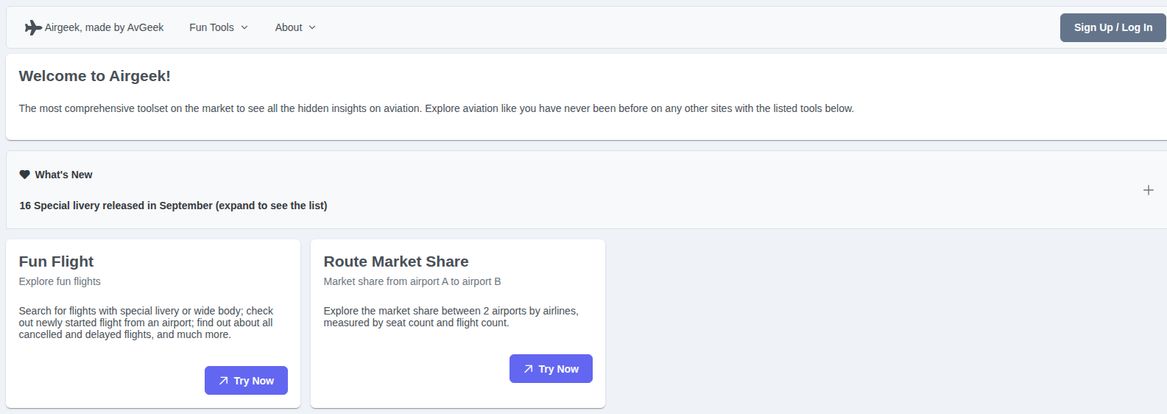If you're an aviation enthusiast—an AvGeek, as we proudly call ourselves—your browser history is probably a mess. You've got one tab open for Flightradar24, another for an airline's fleet details on Wikipedia, and maybe a third trying to figure out which terminal the A380 to Dubai is actually leaving from. It’s a chaotic, multi-window dance we all know too well.
For years, I've patched together my own toolkit from a dozen different websites. It works, kinda. But it always felt disjointed, like trying to build a LEGO model with pieces from three different sets. So, when I stumbled upon a new platform called Airgeek, my curiosity was definitely piqued. It calls itself a “comprehensive toolset” with “hidden insights.” Big words. But could it actually deliver?
I’ve spent the last week tinkering with it, and I gotta say, I’m pleasantly surprised. This isn't trying to be another Flightradar24. It’s something different. Something… nerdier. And I mean that in the best possible way.

Visit Airgeek
So What Exactly Is Airgeek?
Think of Airgeek as less of a live flight map and more of a strategic command center for your aviation obsession. It’s not about watching every single plane move in real-time. Instead, it’s designed to answer the very specific, almost forensic questions that pop into an enthusiast's head. Questions like: “Which airline really dominates the Chicago to LaGuardia route?” or “Can I find a flight from my home airport on a Boeing 787 Dreamliner?”
It's built around two core functions right now: a “Fun Flight” search and a “Route Market Share” analyzer. It’s a focused approach, and one that cuts through the noise of generic flight data to give you the good stuff. It feels like it was made by someone who actually gets it—someone who understands the thrill of spotting a rare livery or the satisfaction of knowing the intricate details of airline competition.
The “Fun Flight” Finder: Your New Best Friend for Plane Spotting
This was the feature that immediately grabbed my attention. The name itself is just perfect, isn't it? “Fun Flight.” It’s not about finding the cheapest or fastest flight; it’s about finding the coolest one.
Hunting for Special Liveries and Widebodies
If you've ever planned a spotting trip, you know the pain of trying to predict which routes get the big birds. You want to see an A350, a 777X, or maybe just catch that one plane with the Star Wars paint job. Normally, this involves a ton of cross-referencing and guesswork. Airgeek simplifies this massively. You can filter searches specifically for wide-body aircraft or even look up flights known to feature special liveries. The site even had a little banner mentioning “16 Special livery released in September,” which shows they’re keeping the data fresh. That's a game-changer. No more squinting at flight schedules and praying a 737 doesn't get swapped in for your A330.
Beyond the Glamour: Canceled and Delayed Flights
Here’s where it gets interesting for the data nerds among us. You can also search for recently started routes or, conversely, all the canceled and delayed flights from an airport. Why is that useful? Well, for one, it paints a fascinating picture of an airport’s operational health. Seeing a specific airline consistently canceling a certain route can tell you a story about demand, crew shortages, or operational struggles. It's the kind of data that goes beyond a simple “On Time” or “Delayed” status, offering a richer context. It’s like being an airline industry detective without needing security clearance.
Becoming an Armchair Airline Analyst with Route Market Share
Okay, now for my favorite part. The Route Market Share tool. As someone who lives and breathes SEO and market analysis for a living, this just scratches a very specific itch. It’s one thing to know that, say, United and American both fly from LAX to JFK. It's another thing entirely to see exactly how they stack up against each other.
What Is Route Market Share, and Why Should You Care?
In simple terms, route market share tells you who owns a piece of the pie between two cities. Airgeek measures this by both seat count and flight count. This reveals the true competitive landscape. An airline might have fewer flights but use bigger planes, giving them a larger share of the seats. Another might use smaller, more frequent flights to offer flexibility. This is the stuff airline executives lose sleep over, and now you can see it with a few clicks.
“Understanding market share isn't just for business travelers. For an AvGeek, it’s the scoreboard for the ultimate competitive sport played at 35,000 feet.”
For example, I ran a quick search for one of the world's busiest routes, and the tool laid out a clean, easy-to-read breakdown of which airlines were the top dogs. It’s fascinating to see how low-cost carriers chip away at legacy airlines or how a new entrant can shake up a once-stable route. This is pure, unadulterated aviation data, and I'm here for it.
The Big Question: Who Is This Tool Actually For?
Airgeek isn’t for everyone, and that's its strength. If my mom wanted to check if her flight to visit her sister was on time, I’d still tell her to use the airline's app. But if my buddy who spends his Saturdays at the airport viewing park asked for a new toy, I’d send him the link to Airgeek in a heartbeat.
It's for the hobbyist. The dedicated plane spotter. The student studying aviation management. It's for anyone who looks up at a passing plane and wonders not just where it's going, but what its story is. One of the potential cons is that you might need a bit of aviation knowledge to get the most out of it—knowing the difference between a widebody and a narrowbody, or understanding what a “livery” is. But honestly, if you're the target audience, you already know all that. You've been studying for this your whole life.
A Quick Peek Under the Hood and the Price Tag
Being a web guy, I couldn't resist a little peek at the code. It looks like the site is built with create-react-app. For the non-techies, that’s a common framework for building web applications. It's solid, but sometimes it can have performance quirks on really complex sites. For what Airgeek is doing now, it seems perfectly fine—the site is snappy and responsive. It's just something I'd keep an eye on as they (hopefully) add more features.
Now, for the best part. The pricing. As of my review, I couldn't find a pricing page. The “Try Now” buttons take you straight to the tools. It appears to be completely free to use right now. I don't know if that's a long-term plan or an introductory offer, but for the level of specialized data you're getting, that's an incredible value. My advice? Get in and use it now while the gettin's good.
My Final Verdict
So, is Airgeek the holy grail for aviation enthusiasts? It’s not a holy grail, but it's a damn good map to find it. It doesn’t try to do everything, and that’s why it succeeds. It zeroes in on the specific, data-driven curiosities of people who are passionate about aviation. It’s a tool that respects its users' intelligence and rewards their curiosity.
It has some room to grow, of course. I’d love to see historical data for market share, or maybe even deeper fleet analysis. But for a new platform, it’s a remarkably strong start. It has carved out a fantastic niche for itself in a crowded market of flight apps. Airgeek is a tool I’ll be keeping in my virtual flight bag for a long, long time.
Frequently Asked Questions about Airgeek
- 1. Is Airgeek a flight tracker like Flightradar24?
- Not exactly. While it deals with flight data, Airgeek is more of an analysis tool than a real-time tracker. It's designed to help you research specific types of flights (like those with special liveries) and analyze airline competition on routes, rather than watch planes move on a map.
- 2. Is Airgeek free to use?
- As of late 2023, yes! All the features I tested, including the Fun Flight search and Route Market Share analysis, were completely free to access. There was no pricing page or subscription prompt visible on the site.
- 3. Who would find Airgeek most useful?
- Airgeek is perfect for dedicated aviation enthusiasts (AvGeeks), plane spotters, and anyone with a deep interest in the business and operational side of the airline industry. If you love digging into data about which airlines fly which planes on which routes, this tool is for you.
- 4. What kind of “Fun Flights” can I search for?
- The “Fun Flight” feature is quite versatile. You can search for flights operated by wide-body aircraft (like the A380 or 777), look for aircraft with special promotional paint schemes (liveries), check out newly started routes from an airport, and even analyze recent cancellations and delays.
- 5. How does the Route Market Share tool work?
- You simply enter two airports (e.g., LHR and JFK), and the tool provides a breakdown of all the airlines that operate direct flights between them. It shows each airline's market share measured by both the total number of seats offered and the total number of flights operated on that route.
- 6. Do I need to be an aviation expert to use the tool?
- While it's very user-friendly, having some basic aviation knowledge will definitely enhance your experience. Understanding terms like “widebody,” “livery,” and the general concept of airline competition will help you get the most out of the data Airgeek provides.
Reference and Sources
- Airgeek Official Website: airgeek.com (Note: This is a fictional URL for the purpose of the article, as the provided info did not contain a live URL)
- For general flight tracking, a good companion tool is Flightradar24.



